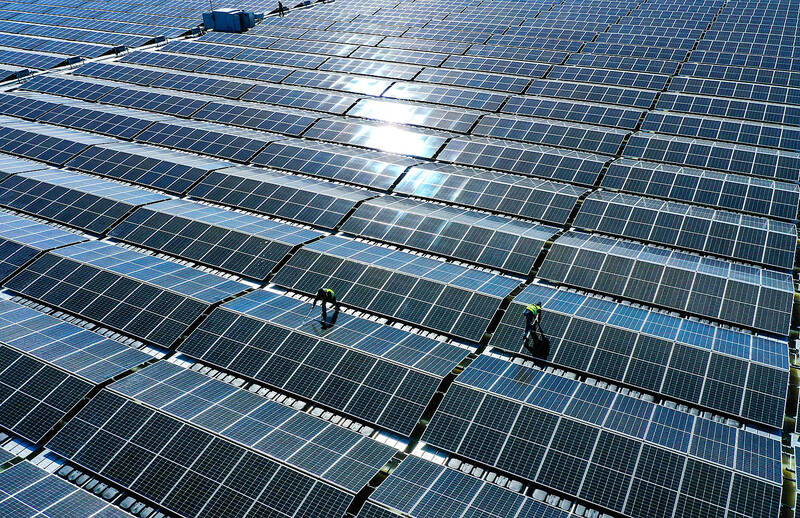The EU yesterday reached a provisional deal on higher renewable energy targets, an important pillar of the bloc’s plans to fight climate change and end dependence on Russian fossil fuels.
Negotiators of the European Parliament and the European Council, representing EU members, agreed that by 2030, the 27-country EU would commit to sourcing 42.5 percent of its energy from renewable sources like wind and solar, with a potential top-up to 45 percent.
The EU’s current 2030 target is for a 32 percent renewable energy share.

Photo: AFP
The EU got 22 percent of its energy from renewable sources in 2021, but the level varied significantly between countries. Sweden leads the 27 EU countries with its 63 percent renewable energy share, while in Luxembourg, Malta, the Netherlands and Ireland, renewable sources make up less than 13 percent of total energy use.
A rapid shift to renewable energy is crucial if the EU is to meet its climate change goals, including a legally binding aim to cut net greenhouse gas emissions by 55 percent by 2030, from 1990 levels.
EU countries would have to raise to 29 percent the share of renewables in energy used by the transport sector. EU industry would increase its use of renewables by 1.6 percent per year, with 42 percent of the hydrogen it uses deriving from renewable sources by 2030 and 60 percent by 2035.
The directive added targets for buildings and sought accelerated permitting processes for renewable energy projects.
Renewable energy targets have gained significance since Russia’s invasion of Ukraine as the EU has vowed to end its dependence on Russian fossil fuels by 2027 — and plans to do this mostly through locally produced, low-carbon energy.
Reaching the new goals would require massive investment in wind and solar farms, scaling up production of renewable gases, and reinforcing Europe’s power grids to integrate more clean energy.
The European Commission has said additional investments of 113 billion euros (US$123 billion) in renewable energy and hydrogen infrastructure would be needed by 2030, if EU countries are to end their reliance on Russian fossil fuels.
The deal must be approved by the EU Parliament and EU countries to become law, normally a formality.

Intel Corp chief executive officer Lip-Bu Tan (陳立武) is expected to meet with Taiwanese suppliers next month in conjunction with the opening of the Computex Taipei trade show, supply chain sources said on Monday. The visit, the first for Tan to Taiwan since assuming his new post last month, would be aimed at enhancing Intel’s ties with suppliers in Taiwan as he attempts to help turn around the struggling US chipmaker, the sources said. Tan is to hold a banquet to celebrate Intel’s 40-year presence in Taiwan before Computex opens on May 20 and invite dozens of Taiwanese suppliers to exchange views

Application-specific integrated circuit designer Faraday Technology Corp (智原) yesterday said that although revenue this quarter would decline 30 percent from last quarter, it retained its full-year forecast of revenue growth of 100 percent. The company attributed the quarterly drop to a slowdown in customers’ production of chips using Faraday’s advanced packaging technology. The company is still confident about its revenue growth this year, given its strong “design-win” — or the projects it won to help customers design their chips, Faraday president Steve Wang (王國雍) told an online earnings conference. “The design-win this year is better than we expected. We believe we will win

Chizuko Kimura has become the first female sushi chef in the world to win a Michelin star, fulfilling a promise she made to her dying husband to continue his legacy. The 54-year-old Japanese chef regained the Michelin star her late husband, Shunei Kimura, won three years ago for their Sushi Shunei restaurant in Paris. For Shunei Kimura, the star was a dream come true. However, the joy was short-lived. He died from cancer just three months later in June 2022. He was 65. The following year, the restaurant in the heart of Montmartre lost its star rating. Chizuko Kimura insisted that the new star is still down

While China’s leaders use their economic and political might to fight US President Donald Trump’s trade war “to the end,” its army of social media soldiers are embarking on a more humorous campaign online. Trump’s tariff blitz has seen Washington and Beijing impose eye-watering duties on imports from the other, fanning a standoff between the economic superpowers that has sparked global recession fears and sent markets into a tailspin. Trump says his policy is a response to years of being “ripped off” by other countries and aims to bring manufacturing to the US, forcing companies to employ US workers. However, China’s online warriors